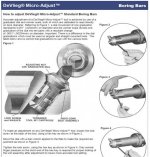geoffw
Aluminum
- Joined
- Feb 21, 2014
- Location
- Las Vegas, NV
I need to bore 2 precision holes that are:
+/- .0002" (.7881 - .7885 diameter) x 1" deep.
+/- .00025" (1.5260 - 1.5265 diameter) x 1.25" deep.
This is my first time using a boring head on a CNC, here is my setup:
-1998 Haas HS1 Horizontal (low hours, less than .0001" runout measured with a ground test bar)
-Criterion Boring Head(s) (.001" Increment) in Solid holders.
-Single point 1/2" carbide boring bars w/CCGT32.51 Insert (1.5" stickout)
-CAT40 Spindle
-500RPM, 2IPM
-7075 Aluminum
When the program is ready for the boring head(s), the machine brings the spindle as close to the operator as possible and the operator will clean the tapers and insert the tools. We have the spindle lugs and the holder marked so the holder is inserted in the same position every time.
We are using a standard boring cycle that bores in and then back out. Its time consuming!
Is there anything that Iam NOT doing that I should be doing? I want to establish a procedure for boring the best quality holes possible, now and in the future!
Here is a picture of the setup, the 2 bores should be pretty obvious. Its a small engine connecting rod:

+/- .0002" (.7881 - .7885 diameter) x 1" deep.
+/- .00025" (1.5260 - 1.5265 diameter) x 1.25" deep.
This is my first time using a boring head on a CNC, here is my setup:
-1998 Haas HS1 Horizontal (low hours, less than .0001" runout measured with a ground test bar)
-Criterion Boring Head(s) (.001" Increment) in Solid holders.
-Single point 1/2" carbide boring bars w/CCGT32.51 Insert (1.5" stickout)
-CAT40 Spindle
-500RPM, 2IPM
-7075 Aluminum
When the program is ready for the boring head(s), the machine brings the spindle as close to the operator as possible and the operator will clean the tapers and insert the tools. We have the spindle lugs and the holder marked so the holder is inserted in the same position every time.
We are using a standard boring cycle that bores in and then back out. Its time consuming!
Is there anything that Iam NOT doing that I should be doing? I want to establish a procedure for boring the best quality holes possible, now and in the future!
Here is a picture of the setup, the 2 bores should be pretty obvious. Its a small engine connecting rod:





